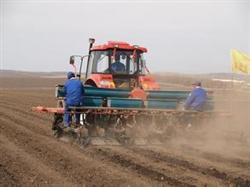Succession of spring corn and transplanting soybean

By using the light and heat resources from spring corn harvest to more than 60 days before autumn sowing, transplanting one-cropping soybean can produce 210 kg soybean per mu. Compared with traditional corn field direct seeding intercropping soybean, the yield of soybean and corn is 130 kg and 160 kg respectively. In the first year, when sowing in autumn, we made a bed 3.6 meters wide, and in the middle and late October, each row of rape was transplanted with 6-7 rows, with a row spacing of more than 0.5 meters. In the first and middle April of the following year, corn was interplanted in rape rows with a row spacing of 0.8 to 0.9 meters. Sowing and cultivating soybean seedlings from June 15 to 18. Varieties such as big bean and green tea bean, which are sensitive to short-day light, were selected and sown in an 8 cm wide ditch with zero idle stubble or other crops, seeds were separated, seeds were sown with 30 seeds per meter, and seedlings were transplanted at the age of 56 and 60 days. When transplanting, soybean seedlings are required to be more than 0.5 meters high, with thick stems and no lodging, with 8 to 10 true leaves. The transplanting period of soybean should be as early as possible, and early seedling should be planted as early as possible. the natural conditions such as shading and moisturizing and stable seedling of transplanted soybean seedling should be used to promote early development. Generally in the first ten days of August, corn was transplanted 10 days before harvest, and two rows of soybeans were transplanted in the board stubble of each corn row, with a row spacing of 0.5 meters, a plant spacing of 0.2 meters, and two seedlings in one hole. Before transplanting, soybeans were fully fertilized with 25 kg calcium superphosphate, 15 kg urea or 45% compound fertilizer 25kg / mu. In the early autumn drought, spray 0.2% potassium dihydrogen phosphate aqueous solution, once every 2 to 3 days, twice in a row. In the later stage, we should pay attention to the control of leaf borer, red spider and other pests.
- Prev

How to cultivate spring soybean
1. Precipitation and temperature in last winter and this spring in autumn and winter last year, the drought in Northeast China was serious, the precipitation was less than usual, and the soil moisture was insufficient. From January to October 2007, the average precipitation in Heilongjiang Province was 402 mm, which was 20% less than that of the same period in previous years.
- Next

Fertilization Technology of Sorghum
Fertilization Technology of Sorghum
Related
- The first cup of black tea in spring, the flavor and history of tea gardens in Kenya, Africa
- The computer can not only choose potatoes, but also grow tea rice. AI will grow winter oolong tea champion.
- It is not only the inflated tea bitten by insects, but also engraved with the four seasons tea in Beipu.
- The Oriental Beauty Tea Festival in Zhuxian County takes the stage at the weekend to experience the plus-size feast of oil tea.
- & quot; Oriental Beauty Tea & Exploration of Emei in Hsinchu, the hometown of quot;
- The new variety of strawberry "Tainong 1" dessert is the first choice with mellow aroma. Crimson gorgeous
- History of Tea in Taiwan: from Wild Inner Mountain to Export Tea Garden
- Two types of Taiwan Oriental Beauty Black Tea won the British three-Star Award for Childhood Tea Xiang Zhang Jiaqi changed from pilot to champion tea maker.
- Banana species and varieties: the planting history of Taiwan Xianren banana and dwarf banana is long, is banana disease resistant?
- Coffee planting Technology: Qianjie Coffee from Seedling to harvesting

